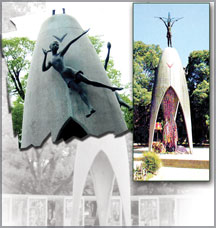Landmarks

A monument commemorating children
Dear Diary,
Tomorrow is Children's Day in Sri Lanka. Therefore, we thought of
flying to see a monument made just for children. We were thinking about
a place to visit when our guide bird came up with the idea of visiting
this special monument in Japan.
It is known as the Children's Peace Monument, and commemorates a
little girl named Sadako Sasaki and the thousands of child victims of
the atomic bombing of Hiroshima. It is located in Hiroshima Peace
Memorial Park, in the city of Hiroshima, and has been designed by native
artists such as Kazuo Kikuchi and Kiyoshi Ikebe.

Sadako is depicted at the top of the Monument, holding a crane.
Thousands of origami cranes, brought from all over the world, are placed
around the monument on a daily basis, with ancient Japanese tradition
holding that a person who folds a thousand cranes can have one wish
granted. The cranes serve as a sign that the children who make them and
those who visit the statue desire a world without nuclear war.
The relevance of the cranes is that Sadako died of leukaemia induced
by bomb irradiation, before she could complete such a string of paper
cranes herself. Beneath the main structure lies a bronze crane that
works as a wind chime when pushed against a traditional peace bell from
which it is suspended, the two pieces having been donated by Nobel
Physics Prize winner Hideki Yukawa.
Akiko, a Japanese citizen, explained the story of Sadako to us. In
1945, the girl named Sadako Sasaki was living in a Japanese city called
Hiroshima along with about half a million other people.
When she was two years old, the first atomic bomb ever to be used
against human beings was dropped on Hiroshima. Sadako was about a mile
and a half away from where the bomb exploded, but she was not burned or
injured at all, at least not in any visible way.
By the time Sadako was in seventh grade, she was a normal, happy,
twelve-year-old girl going to a regular school, studying, and playing
like everyone else. One day, after an important relay race that she
helped her team win, she felt extremely tired and dizzy.
After a while, she felt better, so she thought it was just tiredness.
Over the next few weeks, she tried to forget about it, but the dizziness
kept coming back, especially when she was running. She did not tell
anyone about it, not even Chizuko, her best friend.
Finally, one morning, it got so bad that she fell down and just lay
on the ground. Friends took her to the Red Cross hospital to see what
the matter was. No one could believe what they found out. Sadako had
leukaemia, a kind of cancer of the blood.
Almost everyone who caught the disease died and Sadako was very
scared. She did not want to die.
Soon after Sadako went to the hospital, her best friend, Chizuko came
to visit her. She brought some special paper and folded a paper crane.
Chizuko told Sadako about a legend. She said that the crane, a sacred
bird in Japan, lives for a thousand years and if a sick person folds a
thousand cranes, he/she will get well. Sadako decided to fold a thousand
cranes. Because of the leukaemia, she often felt too weak and tired so
she could not work all the time, but from that day on, whenever she
could, she folded cranes.
On October 25, 1955, surrounded by her loving family, she went to
sleep peacefully for the last time.
However, the story does not end with Sadako's death. She had many
friends who loved her and who missed her very much. Her friends wanted
very much to do something for Sadako. So 39 of her classmates formed a
club and began seeking money to put up a monument for her.
The word spread quickly. Students from 3,100 schools in Japan and
from nine other countries donated money, and finally, on May 5, 1958,
almost three years after Sadako died, they had enough money to build the
monument: the Children's Peace Monument at the Peace Memorial Park in
Hiroshima, right where the atomic bomb was dropped.
In our next 'Landmarks' page, we will be back with our journey
through the world wonders.
Bye.
Comments:
[email protected] |
